Kitchen Cooktops
There are basically five types of kitchen cooktops. Each of these kitchen cooktops have pros and cons. Although there are five different types of kitchen cooktops, there are only two energy sources. These are gas and electric.
Cooking with gas or electric – which is right for you? Let’s look at the benefits of both.
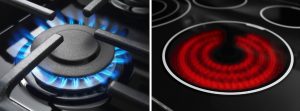
Benefits of Gas Kitchen Cooktops
 Responsive control over the temperature and flame on the cooktop.
Responsive control over the temperature and flame on the cooktop.- Quickly adjust your heat level.
- Gas burners typically have a ceramic cap to keep out spills and debris, while grates are usually removable for easy cleaning.
- Allows you to char or grill food on the open flame cooktop. An open flame can also reach up the side of sculpted pans like woks or skillets.
- Food cooks more evenly. Gas flames spread out over the bottom of a pot or pan, allowing for a greater heating area as opposed to electric burners.
- Gas cooktops are more durable, simpler to use, work with all cookware, and are less expensive to operate.
Benefits of Electric Kitchen Cooktops
 Smooth, easy-to-clean ceramic cooking surfaces are available on select models.
Smooth, easy-to-clean ceramic cooking surfaces are available on select models.- Flat cooktop surface offers more stability for certain pots and pans.
- Frequently easier to install since they plug into an electrical outlet and don’t require a gas hook-up.
- Electric cooktops can feature dual electric elements and electric bridge elements. Dual electric elements feature two distinct rings so you can turn on one or both according to the width of your cookware. Electric bridge elements work as one large element for longer cookware.
Are Gas or Electric Kitchen Cooktops Cheaper?
Overall, gas and electric kitchen cooktops costs are similar. Gas cooktops tend to have slightly higher purchase costs. However, gas tends to be less expensive to operate since natural gas is cheaper than electricity in many states. Gas ranges have the potential for higher installation costs, since you’ll need a dedicated gas line installed if you don’t already have one. These cooktops have fewer parts than electric cooktops and are generally easier to maintain. Gas tends to last longer and be more durable.
Pros and Cons for the Five Types of Kitchen Cooktops
Below is a summary of the pros and cons for each type of kitchen cooktop.
Electric (Also known as radiant cooktops)
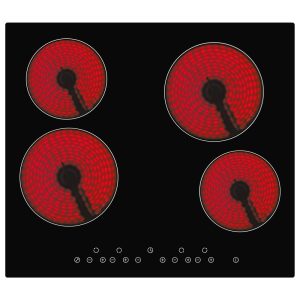 PROS – Heating elements are under a smooth glass surface. This makes cooking and cleaning much easier and safer. Easy to install because they plug into a 220-volt outlet. Provide some residual heat that can help keep food warm or for simmering.
PROS – Heating elements are under a smooth glass surface. This makes cooking and cleaning much easier and safer. Easy to install because they plug into a 220-volt outlet. Provide some residual heat that can help keep food warm or for simmering.
CONS – Electric kitchen cooktops require more time to heat and cool down. This means you have less control over temperatures. The coils (burners) often provide uneven distribution of heat. They also stay hot after you turn them off for a time. This increases the risk of accidental burns.
Induction
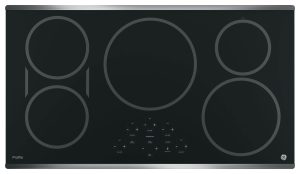 PROS – Burner’s transfer energy rather than heat to the pots and pans. This makes induction more energy efficient. The burners do not get hot, only the pots and pans. Cooking is cooler because there is no loss of heat from the burner. This “cooler cooking” reduces the need to use the exhaust fan and air conditioning to keep the kitchen cool. With induction, temperature changes are faster than with an electric kitchen cooktop. This gives more control to the cook. Easy to clean.
PROS – Burner’s transfer energy rather than heat to the pots and pans. This makes induction more energy efficient. The burners do not get hot, only the pots and pans. Cooking is cooler because there is no loss of heat from the burner. This “cooler cooking” reduces the need to use the exhaust fan and air conditioning to keep the kitchen cool. With induction, temperature changes are faster than with an electric kitchen cooktop. This gives more control to the cook. Easy to clean.
CONS – More expensive to purchase and cook with when compared to electric and gas cooktops. They are also costly to repair. Induction works best with smooth-bottomed stainless steel. If you cook with copper or aluminum, you’ll need to switch your pots and pans.
Natural Gas
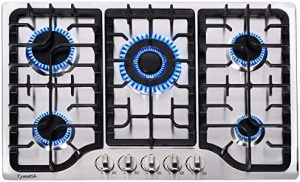 PROS – Instantly increase or lower the heat. This feature alone is what makes natural gas cooktops the choice of professional chefs. The ability to immediately control the heat allows cooks more flexibility in preparing meals and creating desired flavors, textures, and doneness. Gas kitchen cooktops also allow you to use more cooking techniques (like roasting or charring food).
PROS – Instantly increase or lower the heat. This feature alone is what makes natural gas cooktops the choice of professional chefs. The ability to immediately control the heat allows cooks more flexibility in preparing meals and creating desired flavors, textures, and doneness. Gas kitchen cooktops also allow you to use more cooking techniques (like roasting or charring food).
CONS – The open flame can become an instant fire hazard. Natural gas cooktops increase the risk of serious burns and can be dangerous around small children and the elderly. Must be well ventilated to reduce elevated levels of nitrogen and carbon monoxide gases that are emitted from the burners.
Propane Gas
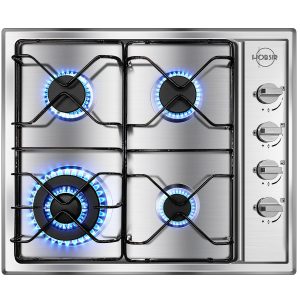 PROS – This connects to an external tank that gets refilled. This is an excellent option if no natural gas source is available. Propane offers all the benefits of natural gas cooking. The biggest benefit of propane is that it produces twice as much energy per unit as natural gas. This means propane uses half the amount of fuel to produce the same cooking results. Depending on where you live, this could save you money.
PROS – This connects to an external tank that gets refilled. This is an excellent option if no natural gas source is available. Propane offers all the benefits of natural gas cooking. The biggest benefit of propane is that it produces twice as much energy per unit as natural gas. This means propane uses half the amount of fuel to produce the same cooking results. Depending on where you live, this could save you money.
Natural gas is a greenhouse gas, while propane is not (propane is non-toxic and is not harmful to water or soil). Propane has no toxicity to harm the environment. It is a safer and cleaner option to natural gas. Last longer than a natural gas cooktop.
Propane kitchen cooktops are converted natural gas cooktops. When converting a lower pressure natural gas fuel supply to a higher-pressure propane gas fuel supply, the propane orifices will be smaller in diameter to accommodate the higher pressure of the fuel supply without releasing too much fuel too quickly.
CONS – Must be delivered by truck to a tank on your property. Tank levels must be monitored to ensure there is enough between fillings. Requires the installation of smaller orifices, correct regulator, and modified burner air shutters.
Combination Natural Gas and Electric (Dual fuel cooktops)
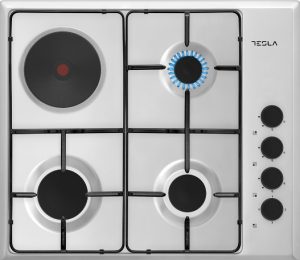 PROS – The typical dual fuel configuration is a gas kitchen cooktop and electric oven. These offer the best of both worlds – gas for cooking and electric for baking. Gas kitchen cooktops offer quick heating and ample temperature control. Electric oven elements cycle in patterns that allow for optimal management of temperatures, making them ideal for baking.
PROS – The typical dual fuel configuration is a gas kitchen cooktop and electric oven. These offer the best of both worlds – gas for cooking and electric for baking. Gas kitchen cooktops offer quick heating and ample temperature control. Electric oven elements cycle in patterns that allow for optimal management of temperatures, making them ideal for baking.
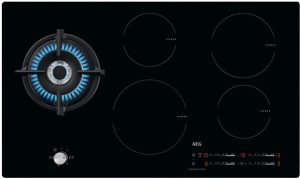 There are also cooktops that have both gas and electric heating. These are available in both gas/electric and gas/induction combinations. Each combine the benefits of electric and natural gas cooking.
There are also cooktops that have both gas and electric heating. These are available in both gas/electric and gas/induction combinations. Each combine the benefits of electric and natural gas cooking.
CONS – These types of cooktops tend to be more expensive than their all-gas or all-electric counterparts. Also, keep in mind that a dual fuel range will require both a gas and electric hook-up. If you do not have a gas line running to your home already, you’ll need to take this cost into account as well. In similar fashion, you will need a 240-volt outlet.
Always Hire a Reliable and Dependable Contractor to Remodel your Kitchen
 Always work with a trustworthy contractor like DAD’s Construction. We are experts in kitchen remodeling who can manage projects in an efficient manner. DAD’s Construction will do everything to minimize the possibility of change orders. Our team will make sure we have all the necessary information to prepare a proposal that meets your requirements. Rest assured that we will provide you with a detailed, by line-item contract. We will make sure that the contents of this agreement are properly and clearly communicated to you. If you have questions or need updates regarding your project, we will always answer your inquiries.
Always work with a trustworthy contractor like DAD’s Construction. We are experts in kitchen remodeling who can manage projects in an efficient manner. DAD’s Construction will do everything to minimize the possibility of change orders. Our team will make sure we have all the necessary information to prepare a proposal that meets your requirements. Rest assured that we will provide you with a detailed, by line-item contract. We will make sure that the contents of this agreement are properly and clearly communicated to you. If you have questions or need updates regarding your project, we will always answer your inquiries.
How Can I Receive More Information on Remodeling my Kitchen?
If you would like more information on enjoying the best bathroom, kitchen, and interior remodeling experience in Orange County, call Dan at (949) 380-0177 or at dan@dadsconstruction.com for a free in home consultation. DAD’s serves all of South Orange County California. This includes Lake Forest, Mission Viejo, Foothill Ranch, Portola Hills, Ladera Ranch, Irvine, San Clemente, Dana Point, San Juan Capistrano, Rancho Santa Margarita, Coto de Caza, Dove Canyon, Laguna Niguel, Laguna Hills, Laguna Beach, Newport Beach, and Aliso Viejo.

 Responsive control over the temperature and flame on the cooktop.
Responsive control over the temperature and flame on the cooktop. Smooth, easy-to-clean ceramic cooking surfaces are available on select models.
Smooth, easy-to-clean ceramic cooking surfaces are available on select models.